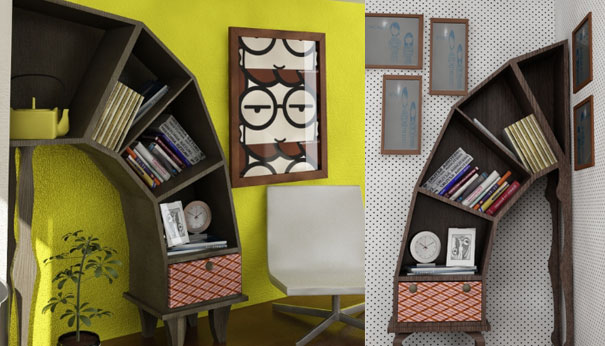Victor Barish’s Disaster Bookshelf
There’s a great line towards the end of 1993’s Tombstone when an emaciated, tubercular, and moribund Doc Holliday (played without a false note by a whisper-thin Val Kilmer) glances at his exposed feet at the end of his hospital bed and says to no one in particular, “I’ll be damned. This is funny.” I don’t know much about Mexican designer Victor Barish’s ostensibly toppling bookcase that he refers to as “The Disaster,” but I know that it has a certain philosophical affinity with the expiring Holliday.
The Disaster. Victor Barish.
Perhaps the joke is principally on residents of California’s Southern Coast, who—so beset by misgivings of the impending and inevitably calamitous “Big One”—might as well outfit their digs as if it had already occurred (or were perpetually occurring). Or maybe the piece is aimed at a sort of general and worldwide apprehensiveness about resource depletion and climate change, suggesting that we should both cultivate a disaster aesthetic and an ironic humor about global chaos and catastrophe.

Whichever the case, Barish’s piece definitely speaks to the now. I place it alongside other harbingers of the apocalypse—like Studio Job’s Industry Table and Chris Rucker’s Lounge Series—though Barish’s tipsy bookcase has about it a genial whimsicality that these two do not. In fact, with the welcome suggestion that we not take ourselves so seriously, Barish drains the notion of “Disaster” of much of its metaphorical punch. Moreover, the piece’s aesthetic has more in common with Tim Burton (especially in his most cartoonish incarnation, a la Coraline and The Nightmare Before Christmas), Salvador Dalí, and Dr. Seuss, than any “serious” commentators on the end of the world. Constructed of ascending rhomboids of face-less MDF cupboards that end in a blunted face plant with a proximal wall, “Disaster” doesn’t so much provide the “experience of a disaster without living it,” as Barish claims, but rather the experience of a topsy-turvy and extremely funny animated world—as if furnishings possessed the same mechanistic unpredictability and penchant for locomoter gymnastics as the ingenious and inspired toy that debuted at the conclusion of the very real apocalypse of World War II—1945’s iconic Slinky.
Via Behance.




Leave a Reply